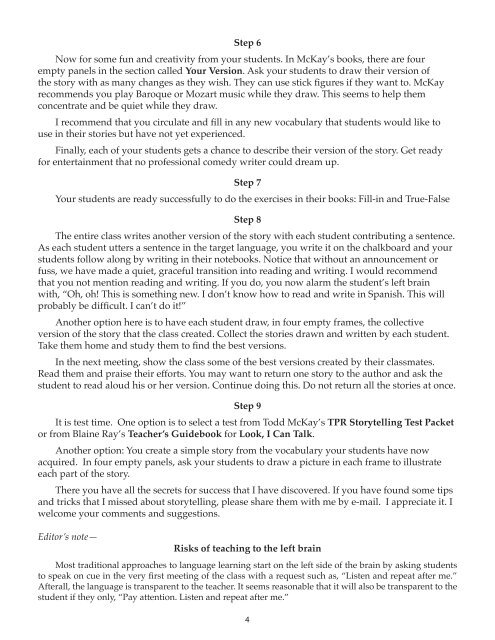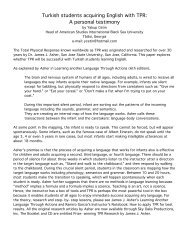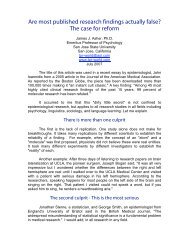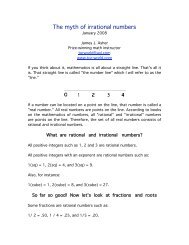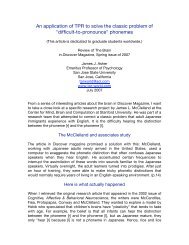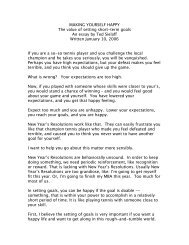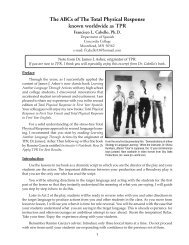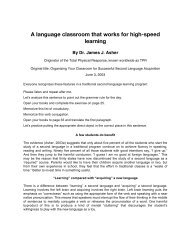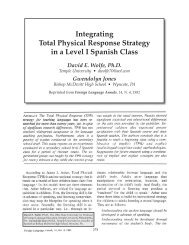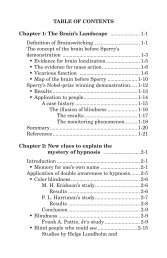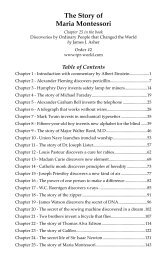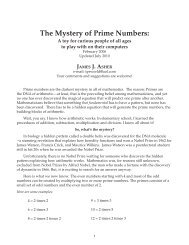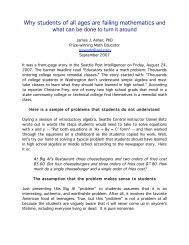A Simplified Guide to Storytelling for Students of All Ages - TPR World
A Simplified Guide to Storytelling for Students of All Ages - TPR World
A Simplified Guide to Storytelling for Students of All Ages - TPR World
Create successful ePaper yourself
Turn your PDF publications into a flip-book with our unique Google optimized e-Paper software.
Step 6<br />
Now <strong>for</strong> some fun and creativity from your students. In McKay’s books, there are four<br />
empty panels in the section called Your Version. Ask your students <strong>to</strong> draw their version <strong>of</strong><br />
the s<strong>to</strong>ry with as many changes as they wish. They can use stick figures if they want <strong>to</strong>. McKay<br />
recommends you play Baroque or Mozart music while they draw. This seems <strong>to</strong> help them<br />
concentrate and be quiet while they draw.<br />
I recommend that you circulate and fill in any new vocabulary that students would like <strong>to</strong><br />
use in their s<strong>to</strong>ries but have not yet experienced.<br />
Finally, each <strong>of</strong> your students gets a chance <strong>to</strong> describe their version <strong>of</strong> the s<strong>to</strong>ry. Get ready<br />
<strong>for</strong> entertainment that no pr<strong>of</strong>essional comedy writer could dream up.<br />
Step 7<br />
Your students are ready successfully <strong>to</strong> do the exercises in their books: Fill-in and True-False<br />
Step 8<br />
The entire class writes another version <strong>of</strong> the s<strong>to</strong>ry with each student contributing a sentence.<br />
As each student utters a sentence in the target language, you write it on the chalkboard and your<br />
students follow along by writing in their notebooks. Notice that without an announcement or<br />
fuss, we have made a quiet, graceful transition in<strong>to</strong> reading and writing. I would recommend<br />
that you not mention reading and writing. If you do, you now alarm the student’s left brain<br />
with, “Oh, oh! This is something new. I don’t know how <strong>to</strong> read and write in Spanish. This will<br />
probably be difficult. I can’t do it!”<br />
Another option here is <strong>to</strong> have each student draw, in four empty frames, the collective<br />
version <strong>of</strong> the s<strong>to</strong>ry that the class created. Collect the s<strong>to</strong>ries drawn and written by each student.<br />
Take them home and study them <strong>to</strong> find the best versions.<br />
In the next meeting, show the class some <strong>of</strong> the best versions created by their classmates.<br />
Read them and praise their ef<strong>for</strong>ts. You may want <strong>to</strong> return one s<strong>to</strong>ry <strong>to</strong> the author and ask the<br />
student <strong>to</strong> read aloud his or her version. Continue doing this. Do not return all the s<strong>to</strong>ries at once.<br />
Step 9<br />
It is test time. One option is <strong>to</strong> select a test from Todd McKay’s <strong>TPR</strong> S<strong>to</strong>rytelling Test Packet<br />
or from Blaine Ray’s Teacher’s <strong>Guide</strong>book <strong>for</strong> Look, I Can Talk.<br />
Another option: You create a simple s<strong>to</strong>ry from the vocabulary your students have now<br />
acquired. In four empty panels, ask your students <strong>to</strong> draw a picture in each frame <strong>to</strong> illustrate<br />
each part <strong>of</strong> the s<strong>to</strong>ry.<br />
There you have all the secrets <strong>for</strong> success that I have discovered. If you have found some tips<br />
and tricks that I missed about s<strong>to</strong>rytelling, please share them with me by e-mail. I appreciate it. I<br />
welcome your comments and suggestions.<br />
Edi<strong>to</strong>r’s note—<br />
Risks <strong>of</strong> teaching <strong>to</strong> the left brain<br />
Most traditional approaches <strong>to</strong> language learning start on the left side <strong>of</strong> the brain by asking students<br />
<strong>to</strong> speak on cue in the very first meeting <strong>of</strong> the class with a request such as, “Listen and repeat after me.”<br />
Afterall, the language is transparent <strong>to</strong> the teacher. It seems reasonable that it will also be transparent <strong>to</strong> the<br />
student if they only, “Pay attention. Listen and repeat after me.”


